Friday, August 18, 2006
田んぼアート ・ The Rice Paddy Art

5月の下旬に植えた田んぼアートがきれいに伸びてきています。植えてから1ヶ月半ぐらいは稲が小さくて、田んぼにひいている水がかなり見えて「まだこれからだ」という感じでしたが、今になったら、それぞれの稲が高く伸びて、見ごろになってきています。。
The Rice Paddy Art fields that we planted in late May have come in beautifully. For about the first month after we planted, the plants were small and rather than the pattern in the rice, visitors saw more of the water in the fields. You could see that it was coming, but that it still needed time. Now however, all of the plants have grown out and the field is at its peak viewing time.
そして、見に来る人が数多く来ています。最近、役場の北口から入ろうとすれば、かなり混んでいる時が多いです。そしてもちろんのことですが、皆が田んぼアートの隣に建っている天守閣まで登って行けば、皆の「あっ、すばらしい」などの声をいっぱい聞きます。
So of course, many people are coming to see it. Recently when you enter through the north entrance of the village hall you must push through the crowd of people. And of course, when all of those people climb up to the keep of the castle (which stands next to the Rice Paddy Art) and look down, we can almost certainly hear cries of "Wow, that's great".
今年は4色目の赤となる稲を植えましたが、隣の写真で見えるように、それがまだ見えてきていません。穂だけが赤くなるので、その穂がまだフルに咲いていないという意味でしょう。その赤くなることを皆楽しみにしています。
This year we introduced a fourth, red color of rice, but as you can see in the photo here, you can't see that red color yet. It is said that only the husks surrounding each individual grain will turn red. I guess we will have to wait a little longer for that red color to appear.
Friday, August 11, 2006
田舎館のねぷた祭り ・ Inakadate's Neputa Matsuri
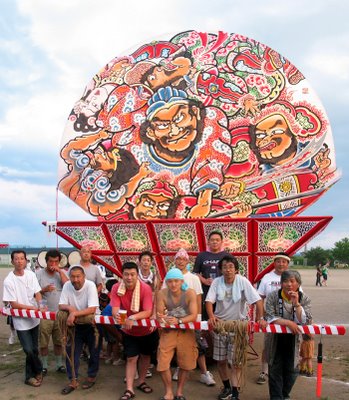
久しぶりのブログ
My first entry in a long time.
最近ブログを書くことがありませんが、是非この写真を載せたいと思いました。8月の1週目は田舎館のねぷた祭りでした。
I haven't written in a long time, but I wanted to get this photo up for everyone to see. It is the Neputa Festival in Inakadate.
その前の1ヶ月ぐらい八反田集落の皆さんが準備を一生懸命やっていました。僕も少しねぷた作りに手伝いに行きました。役立ったかは別問題ですが、手伝うつもりで行きました。
For about a month before the festival, everyone in the Hattanda Neighborhood worked very hard in preparation. I too went to help once in a while. Whether I was any help is a different question, but I did go in order to try and help.
祭りは一週間でしたが、4日は村全体の合同運行でした。この写真はその日出発する直前に撮った物です。何人かが抜けていますが、ねぶたを作った人たちです。。
The festival lasts a week, but August fourth was the all village parade. This photo was taken just before we started. There are a couple people missing, but it is the main people who build the float.
皆様、おつかれさまでした!
Thanks for all your hard work!
Monday, May 08, 2006
New Tambo Art Design・新しい田んぼアートのデザイン
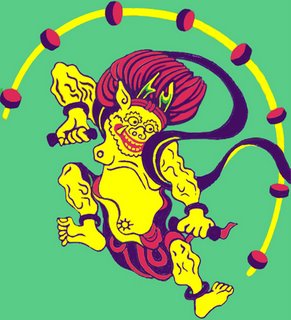
Recently Inakadate announced its new Tambo Art design. This will be the art that decorates the rice field outside the Inakadate Village hall for the next summer.
この前に田舎館村が今年の田んぼアートのデザインを発表しました。これは今度の夏中、村役場の裏側の田んぼを飾るアートとなります。
This year's design is the most aggressive yet with four colors of rice and much more detail than previous years. The design is Fujin and Raijin, a pair of Japanese gods.
今年のデザインは今まで以上に立派なデザインとなります。4色の米を使って、かなり細かいところが多くあります。デザインのメインは日本の神様の風神と雷神となっています。
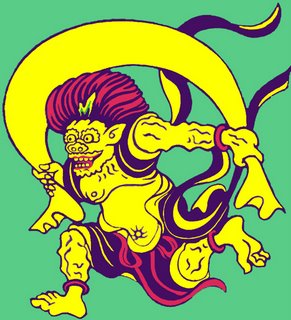 Please plan on coming to Inakadate to see this great natural landscape art. Best times are from mid-July through August. If you would like to help make this project, the Rice Planting Experience event will happen on the morning of May 28th.
Please plan on coming to Inakadate to see this great natural landscape art. Best times are from mid-July through August. If you would like to help make this project, the Rice Planting Experience event will happen on the morning of May 28th. 今度の夏、田舎館の自然の美術作品を見に来てください。見どころは7月の中旬から8月いっぱいです。この田んぼアートを自分で作ることに手伝いたければ、田植え体験ツアーは5月28日に行いますので、来てください。
Contact the Village Hall or the village CIR for more information.
質問がある方は、村役場または国際交流員に連絡してください。
Here is a photo of last year's Ukiyoe Tambo Art. It is all done with three varieties of rice. これは去年の田んぼアートの写真です。全部は三種類の稲でできています。
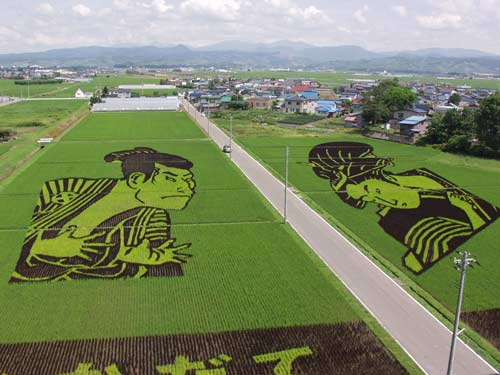
Thursday, April 06, 2006
Fukinoto ・ ふきのとう
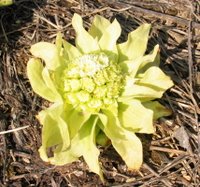 One of the sure signs of spring in Japan are the fukinoto, the first plant that comes out in the spring. This plant is translated at “Butterbur” in a dictionary, but the only place I have ever seen them is in Japan, so the only real term I have ever used for them is “fukinoto.”
One of the sure signs of spring in Japan are the fukinoto, the first plant that comes out in the spring. This plant is translated at “Butterbur” in a dictionary, but the only place I have ever seen them is in Japan, so the only real term I have ever used for them is “fukinoto.”日本では、春が来たという確実のシンボルとして、一番早く地面に上がってくる「ふきのとう」を取り上げることができます。辞書で見れば、この植物の英語の名前は「butterbur」となっていますが、日本以外に見ることがないので、「ふきのとう」という表現しか使ったことがありません。
 Just yesterday I saw my first fukinoto in Inakadate. People in Tokyo are enjoying the cherry blossoms already, but here in Aomori, we are just now getting the fukinoto. From this stage when they are cute buds just popped out of the ground, these fukinoto will grow a little taller and bloom with many small yellow flowers. But I like them better immediately when they come up out of the ground.
Just yesterday I saw my first fukinoto in Inakadate. People in Tokyo are enjoying the cherry blossoms already, but here in Aomori, we are just now getting the fukinoto. From this stage when they are cute buds just popped out of the ground, these fukinoto will grow a little taller and bloom with many small yellow flowers. But I like them better immediately when they come up out of the ground. きのう、田舎館で始めてのふきのとうを見ました。東京の皆さんはさくらを楽しんでいるそうですが、ここの青森では、やっとふきのとうの季節になりました。地面から出たばっかりのかわいいつぼみという現在の状況から少し高く伸びて、黄色い花が咲くことが普通ですが、僕は、今のが一番いいと思っています。
Thursday, March 30, 2006
A Mouse World ・ ネズミの世界

Spring has finally come to Inakadate. The snow is almost all gone, with just a little remaining in shadowed areas. It is wonderful to have wide roads with no snow on them again. It is surprising to see the village again with no snow and much less vegetation. When I came last July there was already green grass hiding lots of things laying on the ground. Now with the grass dead and the snow gone, you can see everything.
田舎館ではもう春がやってきました。雪がほとんど溶けていて、日陰のある所にしか残らない状態です。路面に雪が積もっていない、広い道路を久しぶりに走ることは素晴らしいことです。雪がなく、草がない村を見ることはちょっとびっくりします。去年の7月に来た時、色々な植物が茂っていて、地面にある物をかなり隠していました。しかし今は、雑草、芝生や作物が死んでいて、雪がないので全てが見えます。
 One of the first things that I have noticed is hundreds and thousands of mouse holes and tracks. On my way to and from work every day I walk along the edge of rice field. There in that field, especially on the edge, it looks like a mouse metropolis. Everywhere you look there are holes or little pathways that mice have made or worn during the past winter.
One of the first things that I have noticed is hundreds and thousands of mouse holes and tracks. On my way to and from work every day I walk along the edge of rice field. There in that field, especially on the edge, it looks like a mouse metropolis. Everywhere you look there are holes or little pathways that mice have made or worn during the past winter. 一番最初に気づいたことは数え切れないくらい多くあるネズミの穴と走り道です。出勤して帰る時に僕は、田んぼの端っこを歩いていきます。そこの田んぼの中、特にちょっと高くなっている「畦畔」はネズミの都会のように見えます。どこを見ても、この前の冬にネズミの足が踏み潰した小さい鼠道があります。
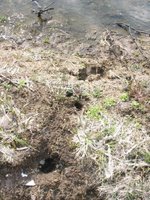 Little did we know that while we were walking or living above the snow, the mice were below it living and prospering in a little world of their own. In a couple weeks or so, the grass will grow or the rain will fall and the mouse world will disappear from view. Some mice might be killed by birds or cats, but many will probably survive. We won’t be able to see the holes and mice anymore, but the mice will probably still be there. I for one will keep this in mind.
Little did we know that while we were walking or living above the snow, the mice were below it living and prospering in a little world of their own. In a couple weeks or so, the grass will grow or the rain will fall and the mouse world will disappear from view. Some mice might be killed by birds or cats, but many will probably survive. We won’t be able to see the holes and mice anymore, but the mice will probably still be there. I for one will keep this in mind.冬中、僕たち人間が雪の上を歩いて、生活していた間に、その雪下で、ネズミが自分の小さい世界でかなり繁栄していたようです。もう数週間して、草や雑草が生えてきたら、今見えるネズミの世界が再び隠されるでしょう。ネズミの何匹かが猫や鳥に殺されるでしょうが、生き残る物も多いでしょう。穴やネズミが見えなくなるでしょうが、ネズミはきっとそこにいるでしょう。僕はこれを頭に入れておきたいと思います。
Wednesday, March 15, 2006
Melting Snow ・ 解けている雪
I haven't written about the weather for a while, but it has changed considerably in the last couple of weeks. On February 14th I wrote an entry about all the snow that we were getting here in Inakadate. About that time I think there was about 140 centimeters on the ground and there were mounds of snow everywhere.
最近、天気のことを書くことはなかったですが、最近の数週間の間、かなり変わりつつです。2月14日に、ここの田舎館での大雪のことをこのブログに載せました。その頃この村には約140cmぐらい雪が積もっていて、どこを見ても雪の山がありました。
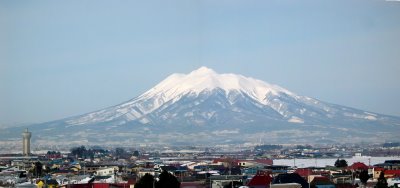 People were making regular trips to the river to dump the snow but still snowbanks were getting higher and roads were getting narrower. Had it continued much longer, houses would have started to disappear.
People were making regular trips to the river to dump the snow but still snowbanks were getting higher and roads were getting narrower. Had it continued much longer, houses would have started to disappear.
村の皆さんが雪を捨てるために川へ数多く往復していたが、それでも道端の雪の山がどんどんと大きくなり、道路が狭くなりました。それ以上、雪が続いていたら、家そのものが埋まってしまう恐れがあったでしょう。
But soon after that, it got warmer and the snow stopped. For a day or two it rained and that was a bad thing. When you add rain to the tons of snow on top of roofs they become really really heavy and there were numerous roofs that collapsed in the area.
しかし、幸運にもその頃から、気温が少し上がり、雪が止みました。雨が降った1日ぐらいがあったんですが、それが最悪だったようです。屋根の上に積もった雪に雨を加えると、雪が落ちずにさらに重くなるため、この地域の数多くの屋根が潰されたそうです。
But with the rain, warmer temperatures and lots of sunshine, the snow has quickly started to melt. I think now we have less than a third or a quarter of what we had three weeks ago. Now most of the roads are their normal summertime width and the 10 centimeters of packed snow is gone. Now when a little more snow falls, people don't have to struggle to find a place to throw it. Now we can look down onto the rice fields rather than across or up.
しかし、雨と暖かい気温と強い日差しのお陰で、この辺の雪が早くと解け始めました。今は3週間前のピークより、3分の1か4分の1しかないような感じです。ほとんどの道路が普通の夏の幅に戻っていて、路面に積もっていた10cmぐらいの雪もなくなっています。そして今は、少し雪が降っても、多くの人が捨てる場所を苦労して探し出す必要がなくなっています。また道路の隣の田んぼを見るのに、上または横から見るのではなく、下から見下ろすことができるようになりました。
Spring is on its way and that's a good thing.
春がもうそろそろという感じです。それは大変いいことだと思います。
最近、天気のことを書くことはなかったですが、最近の数週間の間、かなり変わりつつです。2月14日に、ここの田舎館での大雪のことをこのブログに載せました。その頃この村には約140cmぐらい雪が積もっていて、どこを見ても雪の山がありました。
 People were making regular trips to the river to dump the snow but still snowbanks were getting higher and roads were getting narrower. Had it continued much longer, houses would have started to disappear.
People were making regular trips to the river to dump the snow but still snowbanks were getting higher and roads were getting narrower. Had it continued much longer, houses would have started to disappear.村の皆さんが雪を捨てるために川へ数多く往復していたが、それでも道端の雪の山がどんどんと大きくなり、道路が狭くなりました。それ以上、雪が続いていたら、家そのものが埋まってしまう恐れがあったでしょう。
But soon after that, it got warmer and the snow stopped. For a day or two it rained and that was a bad thing. When you add rain to the tons of snow on top of roofs they become really really heavy and there were numerous roofs that collapsed in the area.
しかし、幸運にもその頃から、気温が少し上がり、雪が止みました。雨が降った1日ぐらいがあったんですが、それが最悪だったようです。屋根の上に積もった雪に雨を加えると、雪が落ちずにさらに重くなるため、この地域の数多くの屋根が潰されたそうです。
But with the rain, warmer temperatures and lots of sunshine, the snow has quickly started to melt. I think now we have less than a third or a quarter of what we had three weeks ago. Now most of the roads are their normal summertime width and the 10 centimeters of packed snow is gone. Now when a little more snow falls, people don't have to struggle to find a place to throw it. Now we can look down onto the rice fields rather than across or up.
しかし、雨と暖かい気温と強い日差しのお陰で、この辺の雪が早くと解け始めました。今は3週間前のピークより、3分の1か4分の1しかないような感じです。ほとんどの道路が普通の夏の幅に戻っていて、路面に積もっていた10cmぐらいの雪もなくなっています。そして今は、少し雪が降っても、多くの人が捨てる場所を苦労して探し出す必要がなくなっています。また道路の隣の田んぼを見るのに、上または横から見るのではなく、下から見下ろすことができるようになりました。
Spring is on its way and that's a good thing.
春がもうそろそろという感じです。それは大変いいことだと思います。
Friday, March 10, 2006
Inakadate's Doll Festival 田舎館のひな祭り
 Last Friday was March third. March third in Japan is the day of the Doll Festival. It is a day to celebrate children (especially girls). Most Japanese people do this by putting out a grand display of dolls in their homes.
Last Friday was March third. March third in Japan is the day of the Doll Festival. It is a day to celebrate children (especially girls). Most Japanese people do this by putting out a grand display of dolls in their homes. この前の金曜日は3月3日でした。日本では3月3日は子供(特に女の子)を祝うひな祭りの日です。ひな祭りの主点として多くの日本人は家で立派な人形を飾ることは取り上げられます。
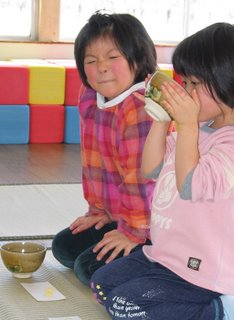 Of course, the preschools that I teach at all had a beautiful display of dolls as well. In addition to the display, the students at the preschool have a mini tea ceremony on this day. This year I was fortunate enough to be invited to Nishi (West) Preschool for their Doll Festival tea ceremony.
Of course, the preschools that I teach at all had a beautiful display of dolls as well. In addition to the display, the students at the preschool have a mini tea ceremony on this day. This year I was fortunate enough to be invited to Nishi (West) Preschool for their Doll Festival tea ceremony. もちろん、僕が訪問する保育所でもひな人形も大きく飾られていました。飾りつけする他に、このひな祭りの日に保育所の子供が小さいお茶会を開きます。今年は僕が田舎館の西保育所のひな祭りお茶会に誘われていました。
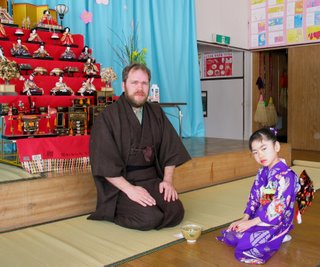 It is quite a grand event. The teachers put out straw mats and the students use real pottery tea bowls. At this preschool, the girls in the oldest class dress up in kimonos and serve tea to the whole school. Interestingly, at this school the oldest class has 14 students, but only 2 of them are girls. So they were two busy little girls.
It is quite a grand event. The teachers put out straw mats and the students use real pottery tea bowls. At this preschool, the girls in the oldest class dress up in kimonos and serve tea to the whole school. Interestingly, at this school the oldest class has 14 students, but only 2 of them are girls. So they were two busy little girls. 立派な催し物でした。茶屋に見えるように、先生たちが床の上に茣蓙(ござ)を敷いておいて、本当の抹茶を使いました。子供たちが本物の陶器の茶碗を使いました。この保育所では年長の女の子が着物を着て、全校の子供たちにお茶を配る習慣があります。今年、年長の子は14人がいますが、その中の2人しかは女の子です。ですから、この2人にとって大変忙しい朝だった感じです。
 As the special guest, I too put on a kimono for the big event. Everyone said I looked great, but..... I also had a seat of honor in front of the doll display. The girls served me bitter tea (mixed by the teachers) and we ate sweet candies to balance the flavors a little bit.
As the special guest, I too put on a kimono for the big event. Everyone said I looked great, but..... I also had a seat of honor in front of the doll display. The girls served me bitter tea (mixed by the teachers) and we ate sweet candies to balance the flavors a little bit. 特別のゲストとして呼ばれた僕も、着物を着ることになりました。皆さんが「似合うな」とほめてくれましたが、どうでしょう..... そして、皆さんの前、雛様の前の上座で座らせました。年長の2人に先生が混ぜてくれた苦いお茶を飲ませてくれました。苦い抹茶と一緒に着いてくる甘いお菓子も食べるといいバランスになりました。
It was a fun time.
大変楽しかったです。
Friday, March 03, 2006
Tofu Making ・ 豆腐つくり教室
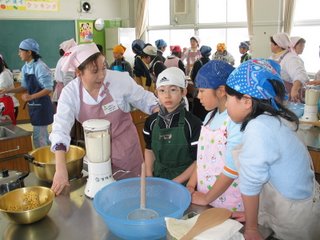 It's been a while now, but a couple of weeks ago I participated in a tofu making class at Inakadate Elementary School. I had been at the school a couple of weeks before and had seen the recipe on the table and when I showed interest they invited me to come.
It's been a while now, but a couple of weeks ago I participated in a tofu making class at Inakadate Elementary School. I had been at the school a couple of weeks before and had seen the recipe on the table and when I showed interest they invited me to come.もうだいぶ前ですが、2週間前に僕は田舎館小学校での豆腐つくり教室に参加しました。その教室の何日か前に学校にいて、レシピを見ましたが、それに興味を示したら、教室に来てくださいと招待してもらいました。
 This event was taught by the women of the local agricultural cooperative who (it seems) are pushing domestic bean production these days. It was really quite interesting and very well organized. The beans had been soaked beforehand so all we had to do was start right in.
This event was taught by the women of the local agricultural cooperative who (it seems) are pushing domestic bean production these days. It was really quite interesting and very well organized. The beans had been soaked beforehand so all we had to do was start right in.この教室は(最近日本国内の豆生産を推進しているような)地域の農協の婦人部が教えていました。大変面白くて、よく準備していました。大豆が前もってに水につけられていたので、教室に入ったらすぐに料理できました。
First we made soy milk by grinding the soaked beans in a blender and boiling the ground bean and water mixture. This we then strained through a mesh bag in order to get soy milk. We also had a bag full of 'lees', the rest of the beans left over after making the milk.
最初は水と一緒に豆をミクサーですりつぶした物を鍋に移して、沸騰させました。これを網みたいな袋に流して、水分を絞りました。これで豆乳ができました。網の袋の中にはおからも残りました。それを皆で分けて持ち帰りました。
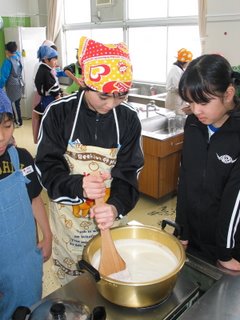 We then took the soy milk and added 'nigari' which I understand is a thickening agent. It immediately reacted with the soy milk and you could see it start to harden. We left it in the bowl for 5 or 10 minutes and then transfered it to a form. The form was lined with cloth and sitting in the sink and we could see the water came off the tofu.
We then took the soy milk and added 'nigari' which I understand is a thickening agent. It immediately reacted with the soy milk and you could see it start to harden. We left it in the bowl for 5 or 10 minutes and then transfered it to a form. The form was lined with cloth and sitting in the sink and we could see the water came off the tofu.その後、豆乳に「にがり」という固める物を足しました。これがすぐに豆乳と科学的に反応して、固まり始めました。5〜10分ぐらいボールのままで固めておいてから、豆腐の型に移しました。型は流しの中において、型の中に布を入れておいたから、 出てきた水は簡単に捨てることができました。
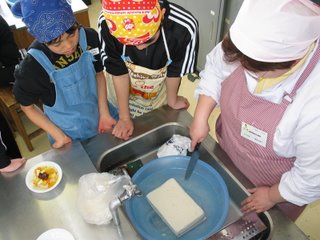 In another 5 or 10 minutes the tofu was ready. We cut it into enough pieces for everyone and sat down to eat. The students all had their regular lunches so it was a full meal for them. The tofu tasted great and everyone enjoyed it a lot.
In another 5 or 10 minutes the tofu was ready. We cut it into enough pieces for everyone and sat down to eat. The students all had their regular lunches so it was a full meal for them. The tofu tasted great and everyone enjoyed it a lot.型に入れてからさらに5〜10分ぐらいしたら、豆腐がもう完成でした。皆の分に小分けして、皿にのせて、テーブルを囲みました。生徒さんたちは皆給食もありましたから、ごちそうになっていました。ちょっと醤油をかけて食べると大変美味しかったです。大変楽しかった、勉強になった豆腐つくり教室でした。
Monday, February 27, 2006
Radio Show ・ ラジオ番組
One thing I haven't yet written about is my radio show. Inakadate has a community radio show which broadcasts to the immediate community here. On a good weather day, the radio signal makes it to the surrounding municipalities. The frequency is FM76.3.
今までこのブログで僕のラジオ番組を取り上げる機会がありませんでしたが、みなさんも知っているように、田舎館には、この近くの地域に放送するコミュニティ・ラジオ局があります。天気がいい日に電波が隣の市町村まで届くような感じです。ラジオ局のFMの76.3です。
 My show is broadcast on Saturday nights. I record a one hour show and it is rebroadcast three times at 9pm, 11pm and 1am. I try to make the show pretty free format. There is usually a theme for each show which has something to do with the events of the day or season. Recent themes, for example, have been Valentine's Day, the Winter Olympics, Mardi Gras, and St. Patrick's Day (upcoming).
My show is broadcast on Saturday nights. I record a one hour show and it is rebroadcast three times at 9pm, 11pm and 1am. I try to make the show pretty free format. There is usually a theme for each show which has something to do with the events of the day or season. Recent themes, for example, have been Valentine's Day, the Winter Olympics, Mardi Gras, and St. Patrick's Day (upcoming).
僕の番組は土曜日の晩に放送しています。僕の番組は、1時間の番組で、前もって録音しているものが、夜9時、11時と深夜1時に放送されます。番組の中身は自由です。普通の番組はその季節またはイベントについてテーマがあるような感じです。最近のテーマはバレンタイン、冬季オリンピック、マーティ・グラー(カーニバルみたいな祭り)とセント・パトリックの日としていました。
Then using that theme as a base, I try to play some interesting or related music. Some weeks, for St. Patricks or Mardi Gras it is easy to find good related music. Some weeks, it is more difficult. But in general the one hour program is half music and half talk. The talk is half in English and half in Japanese (basically the same thing translated) so there is really only 15 minutes of content.
そして、そのテーマを基にして、関連している音楽を流します。テーマに合うような音楽を見つけることは簡単な場合(セントパトリック、マーティ・グラーなど)と難しい場合があります。しかし、全般にいうと、普通の番組は半分音楽と半分しゃべりとなっています。そしてしゃべりは半分 英語と半分日本語ですので、番組を計画するのに15分ぐらいの中身を考えださなければなりません。
 Doing the show is good fun. I prepare during the week and record the shows on Friday afternoon. The radio station and recording studio is at the village's Michi no Eki (a rest area of sorts) and the people who work there are very nice. Here is a photo of everyone there. Of course it is also fun to hear feedback from people who listen to the show. It seems that many people do listen and it is surprising to hear what they think or remember.
Doing the show is good fun. I prepare during the week and record the shows on Friday afternoon. The radio station and recording studio is at the village's Michi no Eki (a rest area of sorts) and the people who work there are very nice. Here is a photo of everyone there. Of course it is also fun to hear feedback from people who listen to the show. It seems that many people do listen and it is surprising to hear what they think or remember.
番組をすることはとても楽しいです。週の間に番組を準備した後、金曜日の午後に録音します。ラジオ局とスタジオは村の道の駅にあり、そこで働いている人々は皆が大変楽しい人です。そこの皆さんの写真を載せます。そして、もちろんのことですが、番組を聴く人のフィードバックを聞くことも楽しいです。数多くの人が聞いている感じですし、皆が何と思うか、または何が記憶に残ったかを聞くことは大変びっくりするものです。
So from now on, if you're in the area on a Saturday night, please be sure to tune your radio to 76.3.
ということで、土曜日の晩、田舎館近辺にいる皆さん、是非ラジオ局を76.3に合わせてください。
今までこのブログで僕のラジオ番組を取り上げる機会がありませんでしたが、みなさんも知っているように、田舎館には、この近くの地域に放送するコミュニティ・ラジオ局があります。天気がいい日に電波が隣の市町村まで届くような感じです。ラジオ局のFMの76.3です。
 My show is broadcast on Saturday nights. I record a one hour show and it is rebroadcast three times at 9pm, 11pm and 1am. I try to make the show pretty free format. There is usually a theme for each show which has something to do with the events of the day or season. Recent themes, for example, have been Valentine's Day, the Winter Olympics, Mardi Gras, and St. Patrick's Day (upcoming).
My show is broadcast on Saturday nights. I record a one hour show and it is rebroadcast three times at 9pm, 11pm and 1am. I try to make the show pretty free format. There is usually a theme for each show which has something to do with the events of the day or season. Recent themes, for example, have been Valentine's Day, the Winter Olympics, Mardi Gras, and St. Patrick's Day (upcoming).僕の番組は土曜日の晩に放送しています。僕の番組は、1時間の番組で、前もって録音しているものが、夜9時、11時と深夜1時に放送されます。番組の中身は自由です。普通の番組はその季節またはイベントについてテーマがあるような感じです。最近のテーマはバレンタイン、冬季オリンピック、マーティ・グラー(カーニバルみたいな祭り)とセント・パトリックの日としていました。
Then using that theme as a base, I try to play some interesting or related music. Some weeks, for St. Patricks or Mardi Gras it is easy to find good related music. Some weeks, it is more difficult. But in general the one hour program is half music and half talk. The talk is half in English and half in Japanese (basically the same thing translated) so there is really only 15 minutes of content.
そして、そのテーマを基にして、関連している音楽を流します。テーマに合うような音楽を見つけることは簡単な場合(セントパトリック、マーティ・グラーなど)と難しい場合があります。しかし、全般にいうと、普通の番組は半分音楽と半分しゃべりとなっています。そしてしゃべりは半分 英語と半分日本語ですので、番組を計画するのに15分ぐらいの中身を考えださなければなりません。
 Doing the show is good fun. I prepare during the week and record the shows on Friday afternoon. The radio station and recording studio is at the village's Michi no Eki (a rest area of sorts) and the people who work there are very nice. Here is a photo of everyone there. Of course it is also fun to hear feedback from people who listen to the show. It seems that many people do listen and it is surprising to hear what they think or remember.
Doing the show is good fun. I prepare during the week and record the shows on Friday afternoon. The radio station and recording studio is at the village's Michi no Eki (a rest area of sorts) and the people who work there are very nice. Here is a photo of everyone there. Of course it is also fun to hear feedback from people who listen to the show. It seems that many people do listen and it is surprising to hear what they think or remember.番組をすることはとても楽しいです。週の間に番組を準備した後、金曜日の午後に録音します。ラジオ局とスタジオは村の道の駅にあり、そこで働いている人々は皆が大変楽しい人です。そこの皆さんの写真を載せます。そして、もちろんのことですが、番組を聴く人のフィードバックを聞くことも楽しいです。数多くの人が聞いている感じですし、皆が何と思うか、または何が記憶に残ったかを聞くことは大変びっくりするものです。
So from now on, if you're in the area on a Saturday night, please be sure to tune your radio to 76.3.
ということで、土曜日の晩、田舎館近辺にいる皆さん、是非ラジオ局を76.3に合わせてください。
Tuesday, February 21, 2006
Birdfeeder Making • 餌台つくり
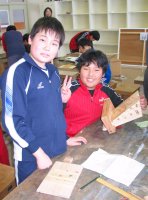
 Last Wednesday, the 6th students at Kodenji Elementary School, several students and I got together during one of the English classes and made birdfeeders. It combined some of my favorite activities, woodworking and nature, and was a great experience which I really liked. Here are some of the photos of that day.
Last Wednesday, the 6th students at Kodenji Elementary School, several students and I got together during one of the English classes and made birdfeeders. It combined some of my favorite activities, woodworking and nature, and was a great experience which I really liked. Here are some of the photos of that day.先週の水曜日、光田寺小学校の6年生と数人の先生と一緒に、英語の時間を使って、餌台を作りました。このプロジェクトは僕の趣味の2つ(木で物を作ることと自然保護)を一緒にしたものです。ですから、僕にとっては大変楽しかったです。その日の写真をここで載せます。
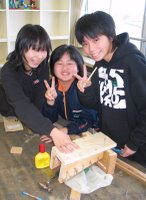
 The 23 students divided into groups of 4 students and together made 6 birdfeeders. I had prepared most of the materials beforehand. There were about 4 or 5 small cuts that were necessary, but after that, all the students needed to do was drill a few holes and nail and screw the boards together. I write that, but because of all the angle cuts, putting the whole thing together wasn't really easy. Still, everyone did a great job.
The 23 students divided into groups of 4 students and together made 6 birdfeeders. I had prepared most of the materials beforehand. There were about 4 or 5 small cuts that were necessary, but after that, all the students needed to do was drill a few holes and nail and screw the boards together. I write that, but because of all the angle cuts, putting the whole thing together wasn't really easy. Still, everyone did a great job.23人の生徒を4人のグループに分けて、6つの餌台を作りました。僕は前もってパーツのほとんどを用意しておきました。4〜5カ所を小さくきる必要があったけど、ほとんどは釘を打ってネジを閉めて、組み立てることだけでした。しかし、組み立てると言っても、斜めのカットとかが多いですから、あまり簡単ではなかったです。しかし、それにしても皆が大変きれいに完成させることができました。

 This activity is the kind of "internationalization" that I really enjoy. I showed the students photos of the birdfeeders and birdhouses that I made in the USA and talked about some of the things I have made with wood. Through this project I was able to talk to the students individually and get to know a little more about about them.
This activity is the kind of "internationalization" that I really enjoy. I showed the students photos of the birdfeeders and birdhouses that I made in the USA and talked about some of the things I have made with wood. Through this project I was able to talk to the students individually and get to know a little more about about them. このようなプロジェクットは僕が大好きな国際交流活動です。アメリカで作った餌台と巣箱の写真を見せたりして、木で出来た物の話を少しできました。このプロジェクトを通して、個人的に生徒と話すことができて、皆を知ることが出来ました。

---------I really had a great time.
大変楽しかったです。
Wednesday, February 15, 2006
Sliding with the Preschool • 保育所とのソリ遊び

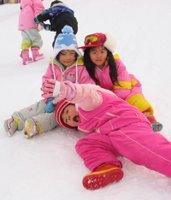 Last week on Wednesday I went sliding with the children from Hatakenaka Preschool. The 3, 4 and 5 year old students all got on the village bus at 9:30 and went to the neighborhood village of Soma. There we stopped at the Romantopia Ski Hill.
Last week on Wednesday I went sliding with the children from Hatakenaka Preschool. The 3, 4 and 5 year old students all got on the village bus at 9:30 and went to the neighborhood village of Soma. There we stopped at the Romantopia Ski Hill. この前の水曜日に畑中保育所の子供たちとソリ遊びに行きました。その日の9時半頃、保育所の3、4、5歳の子供たちが村のバスに乗って、隣となりの相馬という村に向かいました。そこで、ロマントピアというスキー場で止まりました。

 After we dropped off our bags and other stuff we headed to the hill. We only could slide on one small hill to the side of the main slope. The hill was quite narrow for 70 or so little kids to all slide at one time, but the length was probably good and everyone seemed to have a good time.
After we dropped off our bags and other stuff we headed to the hill. We only could slide on one small hill to the side of the main slope. The hill was quite narrow for 70 or so little kids to all slide at one time, but the length was probably good and everyone seemed to have a good time.荷物とかを降ろしてから、山の方へ向かっていきました。僕たちはメインとなるゲレンデの隣にあった小さい坂でしか滑りませんでした。70人ぐらいの子供がいっきに滑るにはちょっと狭すぎるという感じでしたが、長さがそこそこで、皆が楽しんでいたようです。
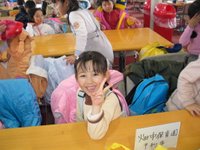
 After an hour or so of sliding we went into the ski lodge and there we had a good lunch of curry rice and ice cream. All of the children seemed to like it very much. All in all, it was a great time. I was able to slide a lot with the kids, but the other teachers were busy watching kids all morning and afternoon long.
After an hour or so of sliding we went into the ski lodge and there we had a good lunch of curry rice and ice cream. All of the children seemed to like it very much. All in all, it was a great time. I was able to slide a lot with the kids, but the other teachers were busy watching kids all morning and afternoon long. 1時間ぐらい滑ったら、ロッジの中に入って、カレーライスとアイスクリームの昼ごはんをご馳走になりました。子供たちが全員美味しく食べたようです。その後、もう一度外に行って、1時間ぐらい滑りました。全体として、皆が楽しく過ごすことができました。僕は何回も子供と滑ることができましたが、他の先生方が子供の見張りする一日だったでしょう。

 After lunch we went back out on the sliding hill. We stayed out there for about another hour and then caught the bus back to Inakadate. After running up and down the hill so many times, most of the kids were really tired and slept most of the way back.
After lunch we went back out on the sliding hill. We stayed out there for about another hour and then caught the bus back to Inakadate. After running up and down the hill so many times, most of the kids were really tired and slept most of the way back.滑り終わったら、もう一度田舎館へのバスに乗りなおして、帰って来ました。登ったり、降りたりの繰り返しの一日でしたので、子供たちが大変疲れていたようです。ほとんどがバスの中で寝てきました。
Tuesday, February 14, 2006
Beautiful Snow ・ きれいな雪
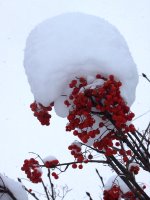
 But the snow isn't all bad. I have seen many beautiful sites here in Inakadate that exist only because of the snow. People complain about the snow, but it is really beautiful too. Because I like to take photos and like the variety, I am enjoy going out and seeing what sites the snow has created for us.
But the snow isn't all bad. I have seen many beautiful sites here in Inakadate that exist only because of the snow. People complain about the snow, but it is really beautiful too. Because I like to take photos and like the variety, I am enjoy going out and seeing what sites the snow has created for us.しかし、この大雪がすべて悪いことではありません。雪が降っているお陰で、田舎館では数多く美しい風景ができています。皆が雪のことを愚痴にしますが、美しい面もあります。写真を撮ることが趣味である僕はこの季節のバライエティが好きです。
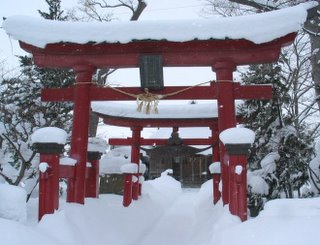
Here are some of the sites I have captured this winter in our village.
以下は今年の冬に僕が撮った冬の写真です。
Monday, February 13, 2006
Hard Work Shoveling ・ 大変な雪かき
 Hopefully the worst is past, but it has been another terrible winter in Inakadate. In the five years I have lived in northern Japan, I had never experienced a white Christmas until this past one. This year the snow started falling about the 10th of December and really hasn't stopped since then.
Hopefully the worst is past, but it has been another terrible winter in Inakadate. In the five years I have lived in northern Japan, I had never experienced a white Christmas until this past one. This year the snow started falling about the 10th of December and really hasn't stopped since then.一番悪いのはもう終わったと僕は楽観的に思っていますが、今年の田舎館の冬はかなり大変です。北東北ではこれが6回目の冬ですが、今までホワイト・クリスマスを過ごしたことがなかったです。しかし今年、12月10日ごろ雪が降り始めて、それ以降、ずっと降り続いている感じです。
 I think that just about everyone in Inakadate and Aomori is getting tired of the snow. Snow is a lot of work here. In my hometown in Minnesota it snows a lot, but because of the wide lawns and large spaces, there is lots of room to throw it. Here however, houses are close and roads have big walls nearby and there is no place to easily get rid of the snow.
I think that just about everyone in Inakadate and Aomori is getting tired of the snow. Snow is a lot of work here. In my hometown in Minnesota it snows a lot, but because of the wide lawns and large spaces, there is lots of room to throw it. Here however, houses are close and roads have big walls nearby and there is no place to easily get rid of the snow.田舎館村と青森県の皆さんはもう雪に飽きてきている感じです。ここの日本では雪ってかなりの仕事になるのです。僕の故郷のミネソタでも雪が降りますが、芝生などの広いスペースがあり、近くに捨てる所がたくさんあります。ここでは、家々が近く建っていたりして、道路の脇にすぐ塀があるから、素早く雪をよせる所がありません。
 That makes for lots of work. Many people put the snow into a truck and haul it to the river. I often see three or four trucks lined up by the river (which never freezes) with people dumping off snow. It looks like a lot of work and I can't imagine Minnesotans doing it. The other day in Hirosaki, I saw more than 100 trucks lined up.
That makes for lots of work. Many people put the snow into a truck and haul it to the river. I often see three or four trucks lined up by the river (which never freezes) with people dumping off snow. It looks like a lot of work and I can't imagine Minnesotans doing it. The other day in Hirosaki, I saw more than 100 trucks lined up.それで、かなりの仕事になります。多くの人が降った雪を軽トラにいれて、川まで運びます。最近その(凍ることのない)川で3~4台の車を並んでいることをよく見ています。大変なようですが、ミネソタ人がそれをすることは想像できません。この前、弘前で100台以上並んでいるトラックも見ました。
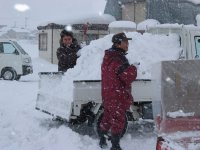 I also see lots of people shoveling snow off their roofs. Only rarely do I see that in Minnesota and then most often people do it from the ground. I would guess that across Japan this winter, probably 20 people have died falling off their roofs.
I also see lots of people shoveling snow off their roofs. Only rarely do I see that in Minnesota and then most often people do it from the ground. I would guess that across Japan this winter, probably 20 people have died falling off their roofs.その他に、屋根から雪を下ろしている人もよく見ています。ミネソタではそれがかなり珍しいことです。そしてアメリカではするなら、長いハンドルのスコップらしい物を使って地面からすることが普通です。今年、日本では、屋根から落ちて怪我した人は数100人を超えているそうです。
I just want to say 'thank you for all your hard work' to the people of Inakadate. Because of this hard work, the environment in which we all live is safe and comfortable.
雪は大変ですが、田舎館の皆さんに「お疲れ様です」ということを言いたいと思います。皆さんの努力のお陰で、村の生活環境はこの大雪の冬でも、安全快適です。
Friday, February 10, 2006
Rope on Hattanda Torii ・ 八反田鳥居の縄
Just a few days ago I was out walking and decided to go and check on the shrine where we had the Naked Festival on January 1st. On that day we carried the large rope to the shrine (from the community center), had a dedication ceremony in the shrine building and then set the rope on the torii archway just temporarily.
数日前に、散歩に出かけていたたら、1月1 日に参加した裸参りの八幡神社に行って見ようと思いました。その裸参りの時、部落の男の人たちが非常に大きい縄を(会館から)神社まで運びました。神社に着いたら、簡単な奉納式をして、その縄を一時的に鳥居に挙げて帰りました。
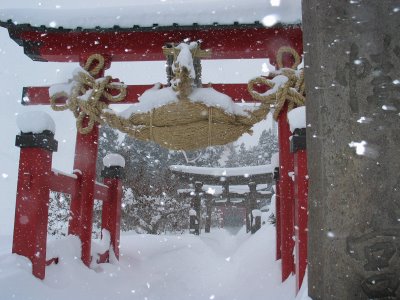 I wondered to myself what has happened since then and when I went back a few days ago, I was happy to see the rope was up and tied in its permanent place. I also understood that it isn't a simple matter of tying it up into place. In the day of the festival I wondered why we didn't tie it up that day, but looking at the detail of the knots that bind the rope to the gate, I can understand why we couldn't do it while still naked. I don't know how long it took, but whoever tied it up there in this cold weather must really be something!
I wondered to myself what has happened since then and when I went back a few days ago, I was happy to see the rope was up and tied in its permanent place. I also understood that it isn't a simple matter of tying it up into place. In the day of the festival I wondered why we didn't tie it up that day, but looking at the detail of the knots that bind the rope to the gate, I can understand why we couldn't do it while still naked. I don't know how long it took, but whoever tied it up there in this cold weather must really be something!
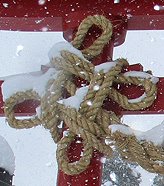 その後、どうなったかと思って行きました。そして行って見たら、僕たちが運んでいった縄が本来の所に立派に結ばれていることを嬉しく見ました。そして、その縄を鳥居に付けることが簡単じゃないと分かりました。当日、「何で今日むすばないんだとう」と思いましたが、その非常に複雑な結び方を見ると、それは裸のままでできなかったと納得しました。どれぐらい時間がかかったか分かりませんが、寒い中、これをした人は偉いな~と思いました。
その後、どうなったかと思って行きました。そして行って見たら、僕たちが運んでいった縄が本来の所に立派に結ばれていることを嬉しく見ました。そして、その縄を鳥居に付けることが簡単じゃないと分かりました。当日、「何で今日むすばないんだとう」と思いましたが、その非常に複雑な結び方を見ると、それは裸のままでできなかったと納得しました。どれぐらい時間がかかったか分かりませんが、寒い中、これをした人は偉いな~と思いました。
It certainly looks great!!
大変素晴らしく見えます!
数日前に、散歩に出かけていたたら、1月1 日に参加した裸参りの八幡神社に行って見ようと思いました。その裸参りの時、部落の男の人たちが非常に大きい縄を(会館から)神社まで運びました。神社に着いたら、簡単な奉納式をして、その縄を一時的に鳥居に挙げて帰りました。
 I wondered to myself what has happened since then and when I went back a few days ago, I was happy to see the rope was up and tied in its permanent place. I also understood that it isn't a simple matter of tying it up into place. In the day of the festival I wondered why we didn't tie it up that day, but looking at the detail of the knots that bind the rope to the gate, I can understand why we couldn't do it while still naked. I don't know how long it took, but whoever tied it up there in this cold weather must really be something!
I wondered to myself what has happened since then and when I went back a few days ago, I was happy to see the rope was up and tied in its permanent place. I also understood that it isn't a simple matter of tying it up into place. In the day of the festival I wondered why we didn't tie it up that day, but looking at the detail of the knots that bind the rope to the gate, I can understand why we couldn't do it while still naked. I don't know how long it took, but whoever tied it up there in this cold weather must really be something! その後、どうなったかと思って行きました。そして行って見たら、僕たちが運んでいった縄が本来の所に立派に結ばれていることを嬉しく見ました。そして、その縄を鳥居に付けることが簡単じゃないと分かりました。当日、「何で今日むすばないんだとう」と思いましたが、その非常に複雑な結び方を見ると、それは裸のままでできなかったと納得しました。どれぐらい時間がかかったか分かりませんが、寒い中、これをした人は偉いな~と思いました。
その後、どうなったかと思って行きました。そして行って見たら、僕たちが運んでいった縄が本来の所に立派に結ばれていることを嬉しく見ました。そして、その縄を鳥居に付けることが簡単じゃないと分かりました。当日、「何で今日むすばないんだとう」と思いましたが、その非常に複雑な結び方を見ると、それは裸のままでできなかったと納得しました。どれぐらい時間がかかったか分かりませんが、寒い中、これをした人は偉いな~と思いました。It certainly looks great!!
大変素晴らしく見えます!
Tuesday, February 07, 2006
Icicles ・ 氷柱(つらら)
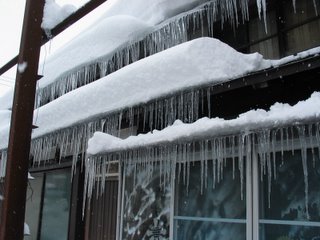 With all the snow Aomori has received in the 6 weeks and temperatures hovering near freezing, Inakadate has become a world of icicles. Most days when the sun shines, the snow melts on rooftops and starts dripping down. When that water hits the eaves and the resulting cooler temperatures (especially at night) they freeze into some huge icicles.
With all the snow Aomori has received in the 6 weeks and temperatures hovering near freezing, Inakadate has become a world of icicles. Most days when the sun shines, the snow melts on rooftops and starts dripping down. When that water hits the eaves and the resulting cooler temperatures (especially at night) they freeze into some huge icicles.今の6週間ぐらい、ここの青森では雪が山ほど降っていて、気温がちょうど氷点に近い関係で、田舎館は氷柱の世界になっています。太陽が出る日には、屋根の上の雪が溶けてきて、少しずつ水がポタッポタッと流れます。日中はいいですが、夜になったら、下からの熱がない
軒のあたりまで行くとその水が冷えて、大きいな氷柱として凍ってしまいます。
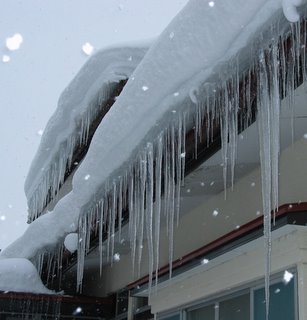 The big ones are great too, but some of the most interesting icicles I have seen happen when the snow slowly slides off the roof, gradually changing the angle of the forming icicles. This then allows the formation of numerous smaller icicles which, more than anything, resemble the teeth of a shark, row after row of sharp spikes ready to do whatever damage they may.
The big ones are great too, but some of the most interesting icicles I have seen happen when the snow slowly slides off the roof, gradually changing the angle of the forming icicles. This then allows the formation of numerous smaller icicles which, more than anything, resemble the teeth of a shark, row after row of sharp spikes ready to do whatever damage they may.超でっかい氷柱もいいですが、もっとも面白い氷柱は雪がゆっくりと屋根から滑り降りて角度を変えていく時にできる物です。この場合は、鮫の歯のように並んでいる数多くの小さい氷柱ができてきます。いつ下を歩いている人に襲いかかるか分からない感じです。
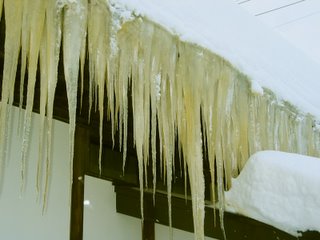
I also discovered that thatched roofs seem to make more and more colorful icicles than metal or tile roofs. These brown and yellow icicles are hanging on one of the village's thatched roof houses.
もう一つの発見ですが、 茅葺きの屋根にできる氷柱がとたん又は瓦の屋根の氷柱よりカラフルであることです。この茶色と黄色の氷柱が村の茅葺きがある家でできているのはすばらしい光景です。
Friday, February 03, 2006
Setsubun ・ 節分
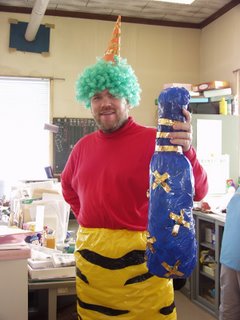 Today is another big day in the traditional Japanese calendar. February 3 is
Today is another big day in the traditional Japanese calendar. February 3 isSetsubun, the day to throw beans at the demons in order to drive them out while at the same time to welcome in good fortune.
今日は日本の伝統的なカレンダーには大事な一日です。2月3日は鬼を追い出して、福を迎える節分です。これをするのに部屋のすみなどに豆を撒いてするそうです。
And who better to play the part of the demon than a big ugly guy with a beard. Yes, I had the honor of being the demon at the Hatakenaka Preschool here in Inakadate this morning. All of the kids loaded up with handfuls of beans and, while screaming 'Oni wa soto' (out with the demons), 'Fuku wa uchi' (in with the good fortune), threw the beans at the terrible oni.
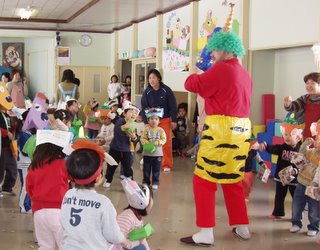 そして鬼の役割をするには、髭を伸ばしていて、醜いやつがいるなら最適だろうと思う人がいるらしいです。ということで、今朝、僕は田舎館の畑中保育所で鬼を演じる名誉を与えられました。子供たち全員が手一杯の豆を持って、「鬼は外、福は内」と叫びならが、怖い鬼に向かって豆を投げて追い出していました。
そして鬼の役割をするには、髭を伸ばしていて、醜いやつがいるなら最適だろうと思う人がいるらしいです。ということで、今朝、僕は田舎館の畑中保育所で鬼を演じる名誉を与えられました。子供たち全員が手一杯の豆を持って、「鬼は外、福は内」と叫びならが、怖い鬼に向かって豆を投げて追い出していました。It seemed to be effective. You could feel a definite increase in the amount of good fortune in Inakadate all afternoon.
そしてこの豆まきがかなり効果的だったようです。きょうの午後、この田舎館では福が溢れているような感じがしていました。
Free Web Counter